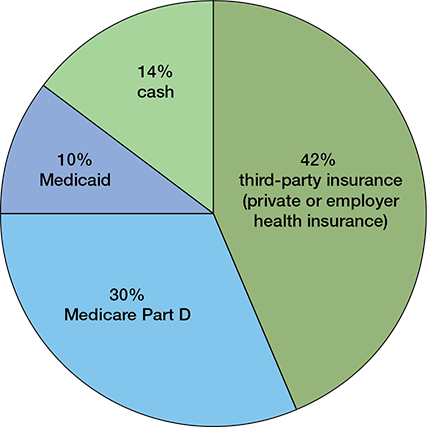8.1 Rising Costs of Health Care
The cost of health care, especially prescription drugs, is far outpacing the rate of inflation. In 2017, spending on prescriptions in the United States was $456 billion. Costs have continued to rise. The reasons include (1) an increase in innovative and expensive new drugs; (2) manufacturers boosting the average wholesale prices (AWPs) of brand name drugs and generic brands; and (3) fewer brand name drugs coming off patent. The AWP is the average price that pharmacies, hospitals, and other healthcare facilities pay for stock of a specific drug. The AWP serves as the benchmark from which insurance companies estimate the percentage of pharmacy reimbursement. The pharmacies then use the AWP to determine the retail price for patients. Most of the current research and development (R&D) pharmaceutical costs are going into creating new and more expensive innovator drugs. The high AWPs of specialty drugs now account for about 33% of all drug spending, and this is projected to reach 50% in the near future (see Figure 8.1).
 Pharm Fact
Pharm Fact
Over 1,000 new genetically engineered, targeted cancer drugs are in development. A monthly course of Votrient (pazopanib), 120 capsules, for renal cancer costs almost $14,000.
On the positive side, more biosimilar and interchangeable drugs will be FDA-approved within the next 5 to 10 years. Some of these drugs will be able to be substituted for the expensive, patented biotechnology drugs, which will help bring down the prices for such expensive medications. This may neutralize some of the swelling research costs of the vast array of new biotechnology drugs being developed.
 IN THE REAL WORLD
IN THE REAL WORLD
In 2019, the FDA approved a new biotechnology drug called atezolizumab (Tecentriq) for the treatment of certain cancers. This injectable drug is currently approved for cancers of the breast, lung, and urinary system. The drug is infused every three weeks. The cost is $12,500 per month.
Figure 8.1 US Prescription Drug Insurance Coverage

Source: Centers for Medicare and Medicaid Services 2017